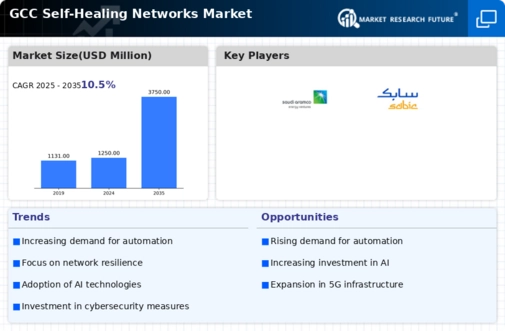The GCC Self-Healing Networks Market is characterized by a dynamic competitive landscape, driven by rapid technological advancements and the increasing demand for automation and resilience in network infrastructures. The self-healing network solutions focus on enhancing a network's ability to quickly identify and resolve issues autonomously, leading to uninterrupted service and reduced operational costs. As the region embraces digital transformation, companies are investing in sophisticated self-healing technologies to harness the potential of artificial intelligence and machine learning.
The competition in this market is fueled by emerging global players and established local firms, each striving to develop innovative solutions that cater to the unique demands of GCC nations. This evolving scenario highlights the role of strategic partnerships, collaborations, and a deep understanding of regional telecom and ICT challenges.Oracle has carved out a significant presence in the GCC Self-Healing Networks Market, leveraging its extensive portfolio of cloud services, data management solutions, and enterprise applications. The company is renowned for its robust self-healing technologies that enable network optimization and intelligent fault management, making their offerings particularly appealing to regional telecom operators and service providers.
One of Oracle's strengths is its ability to provide integrated solutions that combine network flexibility with analytical capabilities, allowing businesses in the GCC to enhance operational efficiency and reliability. Their commitment to innovation and customer-centric services has allowed Oracle to establish a strong foothold within this market, as organizations seek to adopt more resilient network infrastructures amid rising data demands.
VMware also plays a vital role in the GCC Self-Healing Networks Market, known for its innovative virtualization and cloud infrastructure solutions that incorporate self-healing capabilities. The company's key products, such as VMware vSphere and VMware NSX, are designed to enable enterprises to create more resilient and automated network environments. VMware's presence in the GCC market is bolstered by its strategic partnerships with local service providers and its ability to offer tailored solutions that meet the regulatory and operational requirements of the region. The company's strengths lie in its advanced software-defined networking technologies, which facilitate efficient resource management and reduced downtime.
Moreover, VMware's recent mergers and acquisitions have reinforced its market position, enabling it to expand its offerings and deliver comprehensive self-healing solutions that resonate with the unique challenges faced in the GCC landscape.














Leave a Comment